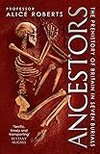
Saved by Margaret Leigh
Ancestors

Saved by Margaret Leigh
Paul Pettitt is currently exploring ‘primate thanatology’ – looking for roots and resonance of human behaviour through ethnographic study that embraces other animals’ behaviours. Among chimpanzees, mothers have been seen carrying dead infants around with them; individuals may visit, smell, touch, hit – and sometimes devour – a corpse. There are so
... See moreAt Wetwang Slack, careful digging and dating allowed the sequence of burials in the cemetery to be disentangled. Clusters formed around primary interments – typically, an older woman buried with beads would be the ‘founder figure’ – her grave forming a focus for subsequent burials of more women, with or without beads. Those gendered clusters also
... See moreThe humanist philosopher Harold Blackham wrote about the British fixation on the dead body in a 1966 essay on re-evaluating ritual: In our own culture the ritual disposal of the corpse accentuates the end, the loss, and at the same time attempts to assuage the grief by the company and sympathy of the mourners and the words of comfort publicly
... See moreWomen are in fact found buried with a great range of grave goods – from beads to items of potentially ritual significance like mirrors and spoons, to weapons.
Those must have been extraordinary funerals. Perhaps the chariots were used as hearses to convey the bodies to the graves in each case. In each of the women’s burials, the chariots were dismantled and laid, in pieces, in the base of the pit, before the body was lowered in – each with a mirror – symbolising power or prophesy, or perhaps both.
As Harold Blackham urged, the most human response to death – the humanist response – is to accept that someone is gone, and remember their life. Not to fixate on their corpse.
The classical writers tell us that Iron Age society was arranged in a hierarchy that bears a striking resemblance to the ideal in Greek and Roman society: peasants at the bottom; artisans, bards and druids in the middle; then nobles; and a single chieftain at the lofty apex of a triangular or pyramidal structure. Women could only gain access to the
... See more‘Roughly where we’re standing, just to the south of the hillfort itself, there was a group of Bronze Age barrows. They were later reused for Saxon burials – that’s fairly common.’ This echoed that reuse of Neolithic tombs in the Bronze Age. ‘It seems to be about more recent incomers wanting to establish their right to the land,’ muses Adrian.
... See moreThe sword and shield appear to have been deliberately broken. The scabbard was laid with its decorated surface lowermost. They have passed from the world of the living. And do the mirror and sword together symbolise a deviation from gender norms? Rising above those norms, or deviating from them? Unifying them? Again, our own prejudices about sex
... See more